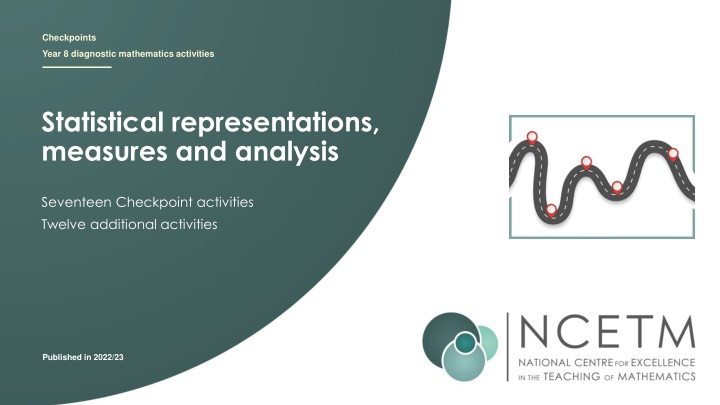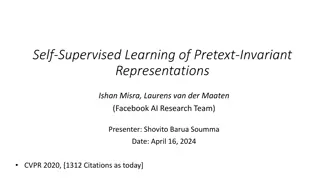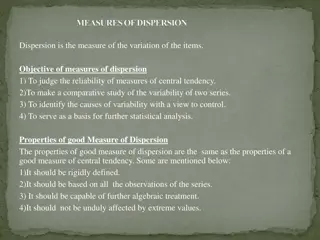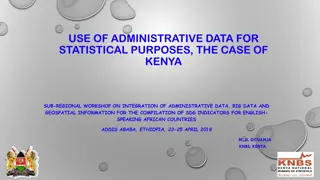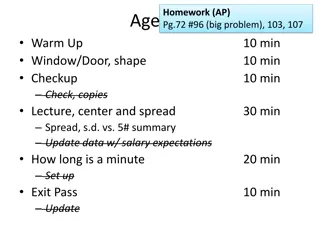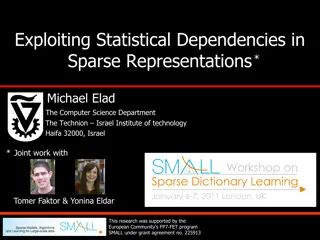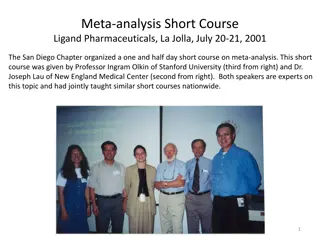Statistical representations, measures and analysis
Explore a comprehensive collection of checkpoint activities in mathematics for Year 8 students focusing on statistical representations, measures, and analysis. Engage with seventeen checkpoint activities and twelve additional activities published in 2022/23. Delve into topics such as comparing charts, line graphs, mean calculations, and more. Enhance your understanding of statistical concepts through practical exercises and guided questions.
Download Presentation

Please find below an Image/Link to download the presentation.
The content on the website is provided AS IS for your information and personal use only. It may not be sold, licensed, or shared on other websites without obtaining consent from the author.If you encounter any issues during the download, it is possible that the publisher has removed the file from their server.
You are allowed to download the files provided on this website for personal or commercial use, subject to the condition that they are used lawfully. All files are the property of their respective owners.
The content on the website is provided AS IS for your information and personal use only. It may not be sold, licensed, or shared on other websites without obtaining consent from the author.
E N D
Presentation Transcript
Checkpoints Year 8 diagnostic mathematics activities Statistical representations, measures and analysis Seventeen Checkpoint activities Twelve additional activities Published in 2022/23
Checkpoints 18 Checkpoint Underpins Code 1: Porky pies 2a: Comparing charts part 1 2b: Comparing charts part 2 3: Line graphs 5.1.2 5.2.2 4: Where is 20? Statistical representations and analysis 5: School trip 6: Football goals 7: Meal deal 8: Mr Chips *This three-digit code refers to the statement of knowledge, skills and understanding in the NCETM s Sample Key Stage 3 Curriculum Framework (see notes below for more information).
Checkpoints 917 Checkpoint Underpins Code 9: Spreading the happiness 10: Equal shares 11: Coming and going 12: Same average 5.1.1 5.2.1 5.2.2 13: Towering Statistical measures and analysis 14: Meanest team 15: Seven is mean 16: Five cards 17: Sports day *This three-digit code refers to the statement of knowledge, skills and understanding in the NCETM s Sample Key Stage 3 Curriculum Framework (see notes below for more information).
Statistical representations and analysis Checkpoints 1 8
Checkpoint 1: Porky pies Mr Lomax Mrs Trubridge Two teachers are comparing the test results from their classes. They draw a pie chart for each class. Not pass Mr Lomax says, More students from my class passed the test. Not pass Pass Pass Is he correct? Why or why not? There were nine students in each class who did not pass the test. What can you say about the size of each class?
Checkpoint 2a: Comparing charts part 1 Favourite colours: Year 10 Which questions can you answer by using the pie charts? Why? a) Which was the most popular colour in each year? b) Compare the number of students who liked yellow best in each year group. c) How many more Year 7 students than Year 10 students liked green best? d) How many students were in each year group? Favourite colours: Year 7 white 9% pink 15% white 10% pink 16% red 7% black 10% black 28% blue 5% yellow 12% red 26% green 21% green 14% blue 15% yellow 12% Write your own question that could be answered by using the pie charts. What can you find out? What can you not find out?
Checkpoint 2b: Comparing charts part 2 Which questions can you answer by using the bar chart? Why? a) Which was the most popular colour in each year? b) Compare the number of students who liked yellow best in each year group. c) How many more Year 7 students than year 10 students liked green best? d) How many students were in each year group? Favourite colours: Years 7 and 10 60 50 40 30 20 10 0 pink red yellow Year 7 green blue black white Year 10 Write your own question that could be answered by using the bar chart. What can you find out? What can you not find out?
Checkpoint 3: Line graphs Farmer Tim counts the vegetables growing in the greenhouse and for sale in the farm shop. He also measures the temperature over time (in C) for both places. He records the information on two line graphs. Describe what information is shown by the arrows marked a to d. Number of vegetables greenhouse shop Temperature C greenhouse shop 30 30 25 25 20 20 a 15 15 10 10 b 5 5 c d 0 0 lettuce cucumber tomato pepper chilli 0:00 6:00 12:00 18:00 0:00 What kind of data could be usefully shown on a line graph? Explain your answer.
Checkpoint 4: Where is 20? For each chart, say how a frequency of 20 is represented. b) a) c) Draw another chart or diagram where a frequency of 20 is represented differently.
Checkpoint 5: School trip The school carries out a survey to help plan the end of term rewards trip. Here are the results from two classes, A and B. Each pictogram uses the same scale. B A Theme park Theme park Museum Museum Theatre Theatre Zoo Zoo How many people do you think are in each class? The pictograms are redrawn using this key: = three people What might the pictograms look like now?
Checkpoint 5: School trip (solution for further thinking question) The pictograms are redrawn using this key: = three people What might the pictograms look like now? Using a total of 26 students for class A and 30 for class B: B A Theme park Theme park Museum Museum Theatre Theatre Zoo Zoo
Checkpoint 6: Football goals Below is a graphic to represent the number of goals scored from 14 matches in a local football league. Lewis says, In five of the games there were two goals scored. Oliver says, There were five goals in the second match. a) Are their statements correct? How do you know? Lewis splits the graphic into two sections, A and B. b) Which section represents more goals? B A The team plays another match. Lewis says, We re bound to score two goals, as this is the most common score. Oliver says, I think we ll score one goal, as we ve not had that score yet. Are their statements correct? How do you know?
Checkpoint 7: Meal deal Cheese (V) 20 12 27 Chicken 36 27 19 Falafel (V) 17 15 16 A shop manager uses the table on the right to record customers sandwich and drink choices in the meal deal. Cola Juice Water The manager carries out some calculations. What do you think she is working out in each case? a) 17 + 15 + 16 b) 12 + 27 + 15 c) 27 + 19 d) 20 + 12 + 27 + 17 + 15 + 16 e) 36 (20 + 36 + 17) f) 36 (27 + 36 + 19) g) 59 + 62 + 48 h) 73 + 54 + 42 The manager wants to draw a graph to show the information in the table. What type of graph might work? What are the challenges?
Checkpoint 8: Mr Chips Mr Chips creates a bar chart to show customers favourite sauces. a) Create a tally chart to show Mr Chips information. Use either your tally chart or the bar chart to work out: b) Which sauce was chosen by one-third of customers? c) Which sauce was four times more popular than gravy? d) Which two sauces, when added together, were chosen by 25% of people? 15 10 5 0 Create a pie chart to represent this data.
Checkpoint 8: Mr Chips (solutions to part a and further thinking question) Type of sauce Tally Total Ketchup 12 No sauce, 50 Mayonnaise 8 Curry sauce 6 Ketchup, 120 Chilli sauce, 30 Gravy 2 Gravy, 20 Chilli sauce 3 No sauce 5 Curry sauce, 60 Mayonnaise, 80
Statistical measures and analysis Checkpoints 9 17
Checkpoint 9: Spreading the happiness Three children have some smiley face stickers: Oskar says, It s not fair, I only have two! a) How can they share the stickers more fairly? Zofia finds another smiley face sticker. b) Can they still share the stickers fairly? Why or why not? Zofia Oskar Maja buys a big box of stickers. They now have a total of 101 stickers. c) Can they still share the stickers fairly? Why or why not? Maja The children hold a party. They are not sure if there will be seven or eight people there, but they want to be able to share some smiley face stickers fairly. How many should they buy?
Checkpoint 10: Equal shares Some friends are sharing a packet of sweets: Hamza: 5 Sarah: 8 Penny: 9 Arthur: 1 Benny: 0 Lucy: 7 a) How could they redistribute the sweets to be shared fairly? b) How could you write your process for part a as a calculation? c) Another friend joins the group. How could they redistribute the sweets now? d) How could you write your process for part c as a calculation? e) What is the same and different about your answers to parts b and d? Why? The friends share a packet of sweets every day. The next day, only five of the friends are there. The day after, all seven are there again. Both days, each person gets the same number of sweets. How many sweets might have been in each packet?
Checkpoint 11: Coming and going Gary s height is exactly the average height for the group of people shown below. a) If Francesco leaves the group, will Gary be above or below the average height for the remaining group? b) If Gary leaves instead, will Ben be above or the below average height for the remaining group? c) If no one leaves, but Seb joins, will Gary be above or below the average height? Francesco is the tallest in the group, and Devon is the shortest. If they both leave, is it possible to say what happens to the average height of the remaining group?
Checkpoint 12: Same average The average age of a class of Year 8 students is 12.5. The average age of their teacher s family is 12.5. a) Does this mean that the teacher s family are the same age as the Year 8 students? Why or why not? Here are the ages of the teacher s family: 0 3 2 5 32 33 b) Explain how the class of Year 8 students has the same average age as the family. A smaller family also have an average age of 12.5. What might their ages be?
Checkpoint 13: Towering The top left picture shows the five tallest buildings in the world. The bottom left picture shows five static caravans. a) Estimate the mean height of the buildings in each image. b) Imagine one caravan swaps with one tower. Estimate the mean height of the buildings in each image now. c) Did both of your estimates change by a similar amount? Explain your thinking. How would your answers to parts a and b be different if the images to the right had been used?
Checkpoint 14: Meanest team In the 2021 22 football season, Chelsea won the Women s Super League, scoring an average of 2.91 goals per game. Maxine says, Wow! Our school team averaged 3.7 goals per match last year. We re better than Chelsea! Do you agree with Maxine? Explain your answer. Find a possible set of ten values that would result in an average of 3.7 Can you do the same for 2.91?
Checkpoint 15: Seven is mean Four sets of data all have a mean of seven. In which sets of data do you think this average provides a good summary of the information? Why? B: 7, 7, 7, 7, 7, 7, 7 A: 1, 1, 1, 1, 1, 1, 43 C: 3.5, 4.8, 6.1, 6.9, 13.9, 17.4, 17.4 D: 4, 5, 6, 7, 8, 9, 10 Neha says that one set of data is more spread out than the others. Which data set do you think she is talking about? Which is the least spread out? How do you know?
Checkpoint 16: Five cards a) What numbers could be on the hidden cards? b) How many possible answers are there? c) Were the cards in ascending order when Molly turned them over? How do you know? d) Molly removes the red card. The mean is now four. What was on the card that she removed? Molly has five cards with positive integers on. She calculates the mean is five. She turns over two cards, so they are no longer visible. 2 5 7 If the task is repeated, but without positive integers specified, how would your responses to these questions change?
Checkpoint 17: Sports day It s sports day! Each year group picks three students to do the long jump. a) Which year group do you think will have the greatest mean height? Can you be sure? The Year 10 team has the greatest mean height. b) Emily says, This means that they must have the tallest student in their group. Do you agree? c) Emily says, This also means they will record the longest jump. Do you agree? The average height of a Year 8 student is approximately 157 cm. The world s tallest man was about 224 cm tall in Year 8. If he was one of the three members of the Year 8 team, how tall would the other two members of the team have to be for their height to still be average for Year 8?
Additional activities Activities A L
Activity A: More porky pies Mr Lomax Mrs Trubridge Two teachers are comparing the test results from their classes. They draw a pie chart for each class. Not pass Not pass Pass Mr Lomax says, More students from my class passed the test. Pass Is he correct? Why or why not? There were nine students in each class who did not pass the test. What can you say about the size of each class?
Activity B: More comparing charts Which of the questions can you answer by using the bar chart and which with the pie chart? a) Which was the most popular colour? b) What colour was chosen by a quarter of students? c) Compare the number of students who liked blue with the number who liked green. d) How many more students liked red than blue? e) How many students were in the class? Saffie asks her class what their favourite colours are. She records their answers two different charts. 8 green 10% 7 pink 25% blue 10% 6 Frequency 5 4 3 red 20% yellow 35% 2 1 0 Pink Red Yellow Colour Blue Green Write your own question that could be answered using the pie chart. What can you find out? What can you not find out?
Activity C: Pocket money Three children have a chart for keeping track of the pocket money they earn for doing chores. The smiley face stickers show the chart after week one. a) If 21 is the total money earned after week one, what can you deduce from the chart shown? b) In week two, sun stickers are added. If each type of sticker represents the same amount, how much does each child now have in total? c) The key shows the actual value of each type of sticker. Calculate how much money each child has. Lucas Jo Olivia = 2 = 6 Is it possible to change the value of each type of sticker to give the same amount of money for each child?
Activity D: Pictogram puzzle This pictogram shows the different ways that students travel to school. Complete the key and the left-hand column based on the clues. The most popular way to travel is walking. One-fifth of students travel by scooter. Less than 10% of students travel by car. Three times as many students travel by bus than by car. Nine students travel by bike. Key: = Create your own pictogram puzzle. What is the minimum number of clues you need to give?
Activity D: Pictogram puzzle (solution) This pictogram shows the different ways that students travel to school. Complete the key and the left column based on the clues. The most popular way to travel is walking. One-fifth of students travel by scooter. Less than 10% of students travel by car. Three times as many students travel by bus than by car. Nine students travel by bike. Key: = 8 students Walk Bus Bike Scooter Car Create your own pictogram puzzle. What is the minimum number of clues you need to give?
Activity E: Bar chart puzzle This bar chart shows the different ways that students travel to school. Label the two axes of the bar chart based on the clues. The most popular way to travel is walking. The least common way to travel is on a scooter. Twice as many people walk as cycle. The number of people who travel by car is three-quarters of the number of people who walk. Twelve people travel on the bus. Create your own bar chart puzzle. What is the minimum number of clues you need to give?
Activity E: Bar chart puzzle (solution) This bar chart shows the different ways that students travel to school. Label the two axes of the bar chart based on the clues. The most popular way to travel is walking. The least common way to travel is on a scooter. Twice as many people walk as cycle. The number of people who travel by car is three-quarters of the number of people who walk. Twelve people travel on the bus. 25 20 Frequency 15 10 5 0 Scooter Bus Car Walk Bike Create your own bar chart puzzle. What is the minimum number of clues you need to give?
Activity F: Whose line is it anyway? 24.5 John and Becky each record the temperatures in their living rooms. John sets up a sensor to continually record the temperature. Becky uses a thermometer to measure the temperature at five different times over 24 hours. a) Which graph belongs to which person? How do you know? b) Both John and Becky use their graphs to find the temperature at 18:00. Is this possible? c) Whose graph is better? Why? 24 23.5 23 22.5 22 21.5 21 4:00 8:00 12:00 16:00 20:00 Can you think of another type of data that could be displayed on a graph like John s? How about Becky s?
Activity G: Population pyramids Match the statements to the population pyramids. The biggest population group is working-age men. The total population is over 100 million. The number of babies born has gone down over time. There are more men than women. The biggest population group is babies and toddlers. There are not many old people. Create your own statements about the population pyramids. Can you think of one that no one else has?
Activity H: Pen diagrams Tilly has 10 pens in her pencil case. black lid 1 2 2 3 1 0 0 1 She draws a Venn diagram to show the different types of pen. a) One category is shown. What might the other two categories be? She replaces one pen with a new pen. b) The Venn diagram now looks like this. Which pen did she remove? What do you know about the new pen? highlighter black lid 1 2 2 cat 3 1 0 0 1 Pick three categories and draw a Venn diagram for your own pencil case.
Activity I: Mean problem What is the mean length of words in this question and its answer? Create your own mean word question.
Activity J: Beginners luck In cricket, the bowling average is the average number of runs the opposing batsman gets before they are out. The best bowlers have a low bowling average. James Anderson is a leading bowler who has bowled 37077 times. He has a bowling average of 26.32. David Gower is a batsman who has bowled 36 times. He has a bowling average of 20. Is David Gower a better bowler than James Anderson? Can you think of some other examples of situations where a low average is best? Can you think of some examples where a high average is best?
Activity K: Queen Elizabeth II 94% of global population were born after Elizabeth ll became Queen. Source: BBC and UN Population Division a) How is this possible? b) How do the additional facts below help to explain this statistic? 1952 2.6 billion 37.2 babies per 1000 people 47 years 2022 7.9 billion 17.7 babies per 1000 people 73.2 years Global population Global birth rate Global life expectancy Queen Elizabeth II reigned for 70 years. Estimate how many people in the world are older than 70.
Activity L: Data collection Mrs Symonds, the headteacher, is redecorating the school hall and wants to use some data to help her decide which colour to choose. This is her process: Represent in a pie chart; choose biggest sector Need to decide new colour for school hall Survey Year 11 s favourite colours a) Is this a sensible data collection process? Why or why not? Below is part of another data collection process that Mrs Symonds uses. b) What might she be trying to find out? Why? How might she collect her data? Calculate the average number of vehicles per hour passing school at different times of day Create your own data collection process. What do you want to find out? How will you collect your data? How will you present your data?
Key: = Key: = The most popular way to travel is walking. One-fifth of students travel by scooter. Less than 10% of students travel by car. Three times as many students travel by bus than by car. Nine students travel by bike. The most popular way to travel is walking. One-fifth of students travel by scooter. Less than 10% of students travel by car. Three times as many students travel by bus than by car. Nine students travel by bike.
The most popular mode of transport is walking. The least common mode of transport is on a scooter. Twice as many people walk as cycle. The number of people who travel by car is three-quarters of the number of people who walk. Twelve people go on the bus to school. The most popular mode of transport is walking. The least common mode of transport is on a scooter. Twice as many people walk as cycle. The number of people who went in a car is three-quarters of the number of people who walked. Twelve people go on the bus to school.
